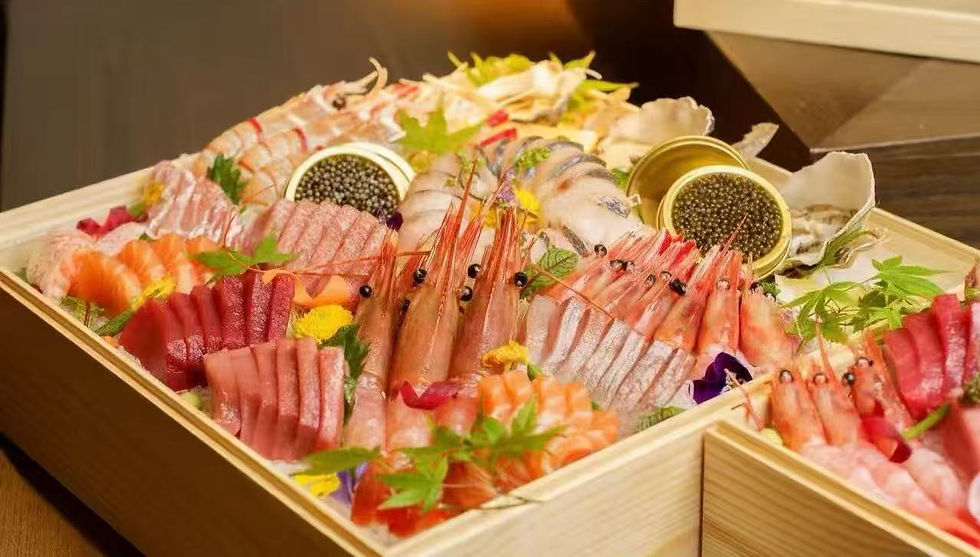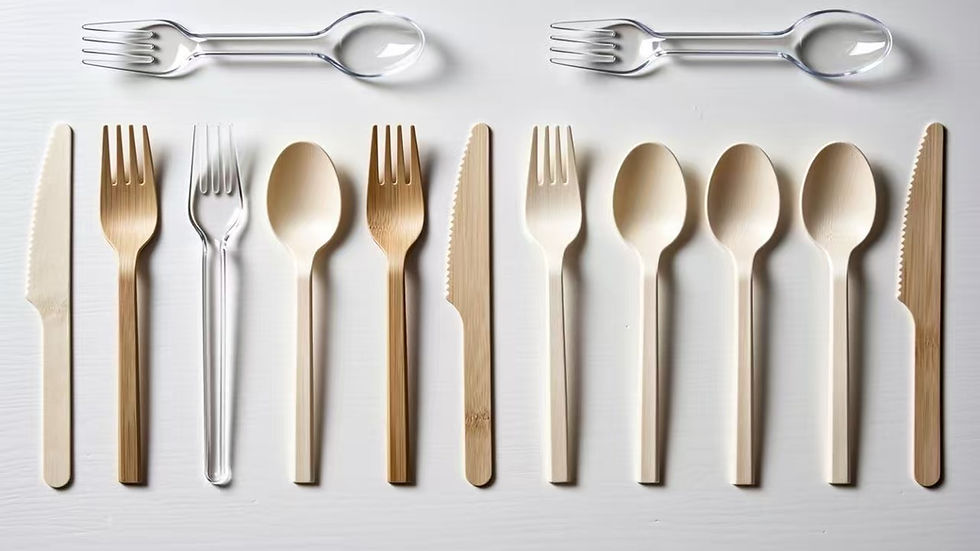How to Choose the Perfect Sushi Box for Your Next Gathering
- abel zhao
- Oct 14
- 5 min read
Updated: Oct 24
If you’re planning to serve sushi at your next gathering—whether it’s a birthday party, corporate lunch, or casual weekend event—a carefully chosen sushi box can transform your meal into an elegant dining experience. The right box keeps your sushi fresh, beautiful, and easy to serve, while also impressing your guests.
This guide covers everything you need to know: from box styles and materials to presentation ideas, freshness tips, and sustainable options.
Understanding Sushi Boxes
What Is a Sushi Box?
A sushi box is a container for ready-to-serve food. It holds sushi rolls, nigiri, or sashimi. You can use it for takeout, catering, or home gatherings. Modern sushi boxes often have separate sections. These sections are for soy sauce, wasabi, and pickled ginger. This way, each item stays fresh and organized.
Types of Sushi Boxes
Classic Sushi Tray – This is a flat box. It has a clear lid. It works well for rolls and nigiri.
Compartmentalized Bento Box – This box has separate sections. It holds sushi and other foods like salad or tempura.
Pressed Box Sushi (Oshizushi) – This sushi is compact and molded. It has a neat and uniform look.
Hybrid Sushi-Bento Box – This style mixes sushi with small sides and sauces.
Eco Sushi Box – This box is made from compostable materials. These materials are things like sugarcane bagasse or bamboo.

sushi box types
Factors to Consider When Choosing a Sushi Box
Guest Preferences & Portions
Plan for 6 to 8 pieces of sushi for one person. Do this when sushi is the main food. If there are other foods, plan for 4 to 6 pieces. For many people, use separate boxes. This is easy for serving. It is also clean. Give people different sushi. Have cooked fish, raw fish, and no-meat sushi. Then all people will like it.
Dietary Restrictions & Allergen Safety
Think about food problems and special diets. Use clear writing on the boxes. Write "has fish" or "no meat." Have soy sauce with no gluten. Do not put no-meat sushi with fish sushi. No-meat sushi has avocado or cucumber. This keeps the foods apart.
Occasion, Theme & Presentation
Pick a sushi box that fits your event.
For office events, use simple black boxes with clear lids.
For parties with friends, use brown boxes made from plants.
For fancy events, use wood or shiny boxes. This looks nice.
Make the sushi look good. Use different colors. Make the food neat.
Packaging Material & Sustainability
People now want boxes that help the planet.
Use materials that break down or can be recycled.
Use bagasse. This is made from sugarcane. It is strong and breaks down.

Use kraft paper. It is light and can be recycled. It is good for big events.

Use PLA or bamboo. It looks nice and is safe for food.
Comparison of Sushi Box Materials

Transport, Freshness & Temperature Control
Sushi must stay fresh. Keep it very cold during storage and moving. Use special bags or boxes with ice packs. For outdoor events, put the sushi on ice. Choose boxes with small air holes. This stops wetness inside.
For over 50 people, plan delivery times carefully. Do not let the sushi sit out.
Cost & Budget Balance
The price changes based on the material, size, and design. Plastic or brown paper boxes are low cost. They work well. Wooden or printed boxes cost more. They look much nicer. If you have many events, buy a large amount. This makes each box cheaper.
Different Styles of Sushi Boxes
Sushi Box
Many restaurants use this style. Rolls and nigiri sit in neat rows. One person can eat it. A group can share it.
Box Sushi (Pressed Sushi)
This style is Oshizushi. A mold presses the rice and fish. The sushi becomes a tight rectangle. Every piece looks the same. You can stack the pieces for show.
Bento Box Sushi
This box holds sushi and other food. It may have miso soup, tempura, or salad. It is a complete meal. It is good for lunch or simple events.
Sushi Bento Box (Hybrid)
This bento box focuses on sushi. It has small areas for extra food and sauces. People who like variety will enjoy it.
Traditional Wooden Sushi Box
Use this box for fancy events. It is wood and you can reuse it. It keeps sushi fresh. It also looks traditional.
Sourcing and Ordering Your Sushi Boxes
Local vs. Online Suppliers
Local caterers or sushi chefs often include sushi boxes in catering packages.
Online packaging suppliers like Boxes4Products, BoxIt Packages, or OXO Packaging offer customizable options in bulk.
For branded events, you can add custom logos or stickers, though this usually requires a minimum order and 1–2 weeks of lead time.
What to Look for in a Quality Sushi Box
Leak-proof and tight-seal lids
Food-grade, BPA-free materials
Internal dividers to prevent sushi from moving
Clear window for display
Appropriate size—avoid oversized boxes that cause sliding
Sourcing and Ordering Your Sushi Boxes
Local vs. Online Suppliers
You can buy sushi boxes from local suppliers. You can also buy them from online suppliers.
Local caterers or sushi chefs often include sushi boxes in their catering packages.
Online packaging suppliers like Boxes4Products, BoxIt Packages, or OXO Packaging sell customizable boxes. You usually have to buy a large amount.
For branded events, you can add custom logos or stickers. But this usually requires a minimum order. It also needs 1–2 weeks of lead time.
What to Look for in a Quality Sushi Box
The box should be leak-proof and have a tight-seal lid.
The materials must be food-grade and BPA-free.
Internal dividers are good because they stop sushi from moving.
A clear window is useful so you can see the sushi.
Get the right size box. An oversized box will let the sushi slide around.
Presenting Your Sushi Box

Creative Arrangements & Visual Appeal
The presentation should stimulate both sight and appetite.Mix bright and neutral tones—think salmon orange, seaweed green, and rice white. Add minimal garnishes such as microgreens or edible flowers.Layer different sushi types to create depth and visual rhythm.
Pairing with Sides and Drinks
Complement your sushi box with:
Sides: seaweed salad, edamame, or pickled vegetables.
Drinks: green tea, sparkling water, sake, or light Japanese beer.
Condiments: soy sauce, ponzu, or spicy mayo in mini containers.
Provide a light dessert, like yuzu sorbet, to cleanse the palate.
Keeping It Fresh
Store boxes in coolers until serving time.
Avoid direct sunlight or prolonged exposure to heat.
Rotate boxes gradually from cold storage to serving trays.
Sushi should not sit at room temperature for more than 2 hours.
Conclusion
Choosing the right sushi box balances style, freshness, convenience, and sustainability.Think about your guests' needs. Think about the event type. Think about serving logistics.A well-planned sushi box makes serving easier. It also makes the dining experience better.
Try different box types. You can use pressed sushi molds or eco-friendly bento designs.Make thoughtful choices. Your sushi box will impress guests before the first bite.
FAQ
Q1: How many sushi pieces should I plan per person?If sushi is the main course, plan 6-8 pieces per person. If it is for a buffet, plan 4-6 pieces.
Q2: Are sushi boxes safe for outdoor events?Yes. Keep the boxes cold. Use insulated containers or ice. Keep boxes out of the sun. Serve them within two hours.
Q3: Can I make vegan or gluten-free sushi boxes?Yes. Use avocado, cucumber, and tofu. Label the boxes clearly. Provide gluten-free soy sauce.
Q4: What materials work best for sushi boxes?Eco-friendly materials work well. Use bagasse pulp, bamboo, or kraft paper. These are strong. For longer storage, use BPA-free plastic with secure lids.
Q5: When should I order sushi boxes?Order custom boxes 1-2 weeks early. Order catering boxes one week early. This ensures you get fresh boxes.
WhatsApp: +86 13867471335 Email: abel@mana-eco.com



Comments